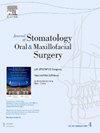裂隙类型对语言成绩有影响吗?法语鼻平衡测试的验证。
IF 1.8
3区 医学
Q2 DENTISTRY, ORAL SURGERY & MEDICINE
Journal of Stomatology Oral and Maxillofacial Surgery
Pub Date : 2024-11-19
DOI:10.1016/j.jormas.2024.102159
引用次数: 0
摘要
目的:鼻腔测量仪是研究和临床实践中最广泛使用的客观发音评估工具。法国标准已在全唇腭裂病例中得到验证。本研究的目的是对发育性腭裂进行第二次验证研究。我们从首次验证中选出了 15 个最敏感、最特异的项目,以创建一个适合在临床环境中使用的测试。次要目标是确定裂隙类型对鼻测量的影响:方法:共招募了 39 名患有孤立性或非孤立性发育性腭裂的参与者进行研究。语言治疗师对发音进行盲法主观评估。鼻音测量评估基于与法国国家科学研究中心语音学和音韵学实验室合作开发的语料库。该语料库由语音平衡的项目组成:结果:获得的鼻音平衡阈值在 11% 到 40% 之间。研究证实了发声效应的存在,即发声辅音的发音与较高的鼻音得分相关。这种效应以前未在其他研究中观察到,是法语语音学特有的。与完全唇裂的受试者相比,有脑下裂的受试者表现出更高的鼻音得分:结论:通过验证最相关的刺激物,可以建立法语鼻平衡测试。结论:通过验证最相关的刺激,可以建立一个法语鼻平衡测试,为了统一评估方案,在主观评估中使用该测试的项目是合适的。本文章由计算机程序翻译,如有差异,请以英文原文为准。
Does the type of cleft have an impact on language results? Validation of the Nasalance test in French
Objectives
The nasometer is the most widely used tool for objective assessment of phonation in both research and clinical practice. French standards have been validated in cases of total cleft lip and palate. The objective of this research is to propose a second validation study on velopalatal clefts. The 15 most sensitive and specific items from the initial validation were selected to create a test that is suitable for use in a clinical setting. A secondary objective is to ascertain the impact of cleft type on nasometry.
Methods
A total of 39 participants with an isolated or non-isolated velopalatal cleft were recruited for the study. A speech therapist conducted a blinded subjective evaluation of phonation. The nasometric assessment was based on a corpus developed in collaboration with the CNRS Phonetics and Phonology Laboratory. The corpus is composed of items that are phonetically balanced.
Results
The obtained nasalance threshold values ranged from 11 to 40%. The study corroborated the existence of a voicing effect, whereby the articulation of voiced consonants was associated with a higher nasalance score. This effect, not previously observed in other studies, is specific to French phonetics. Participants with a velopalatal cleft exhibited higher nasalance scores compared to those with a total cleft.
Conclusion
By validating the most relevant stimuli, a French Nasalance Test can be established. With a view to harmonising assessment protocols, it would be appropriate to use the items from this test in subjective assessment.
求助全文
通过发布文献求助,成功后即可免费获取论文全文。
去求助
来源期刊

Journal of Stomatology Oral and Maxillofacial Surgery
Surgery, Dentistry, Oral Surgery and Medicine, Otorhinolaryngology and Facial Plastic Surgery
CiteScore
2.30
自引率
9.10%
发文量
0
审稿时长
23 days
 求助内容:
求助内容: 应助结果提醒方式:
应助结果提醒方式:


